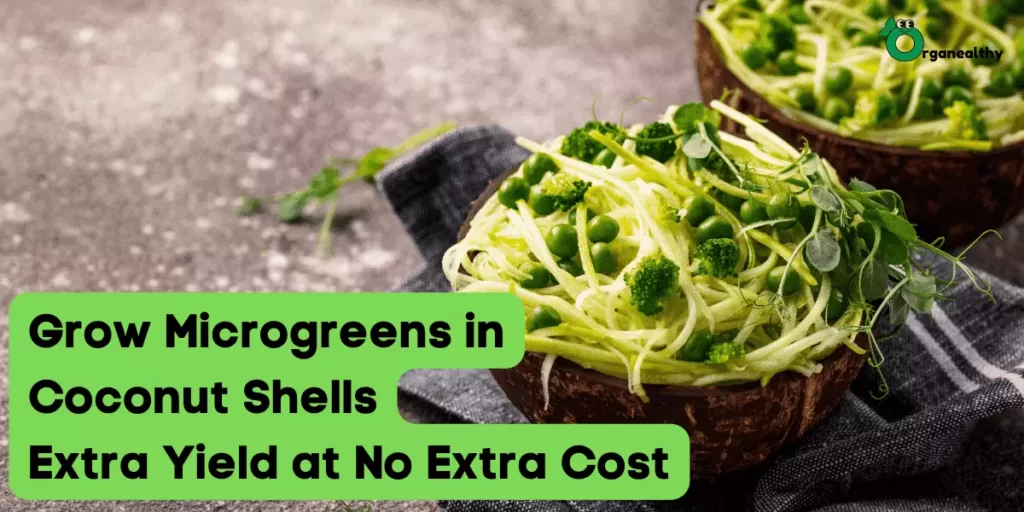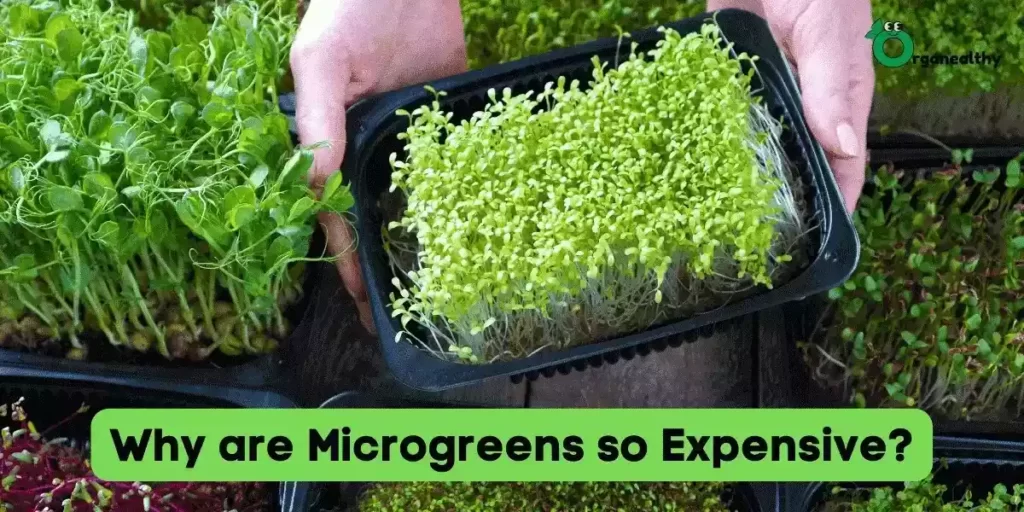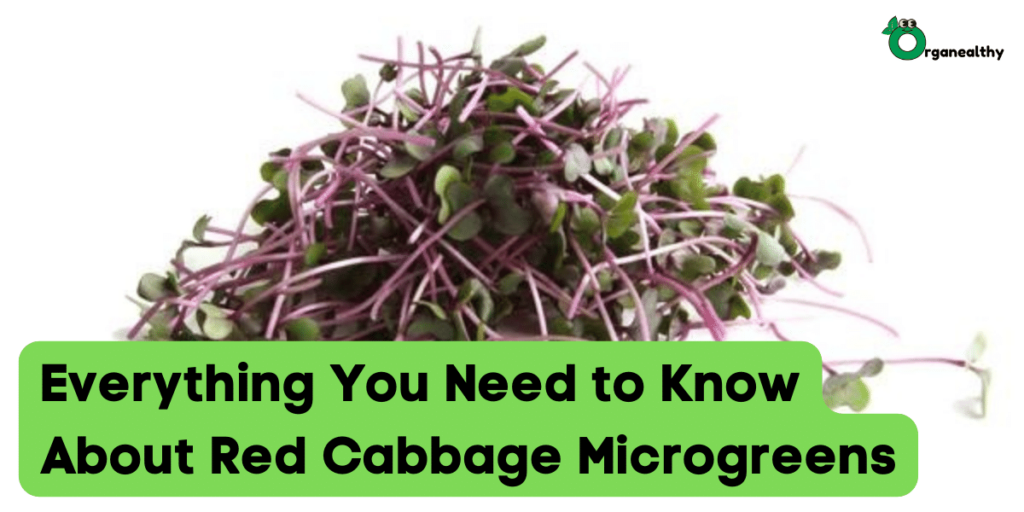Microgreens are known to be superfoods due to their high nutritional composition and amazing health benefits.
But some of you, just some of you, might not like their raw taste and might do the mistake of cooking them. This not only ruins their taste but also lowers their nutritional value substantially.
If you want all the essential nutrients from the microgreens – EAT THEM RAW.
Today, I will share 9 best tasting microgreens that add a dash of aesthetics to your daily meals and give you all the nutrients you need for the day.
So, let’s dive into the article.
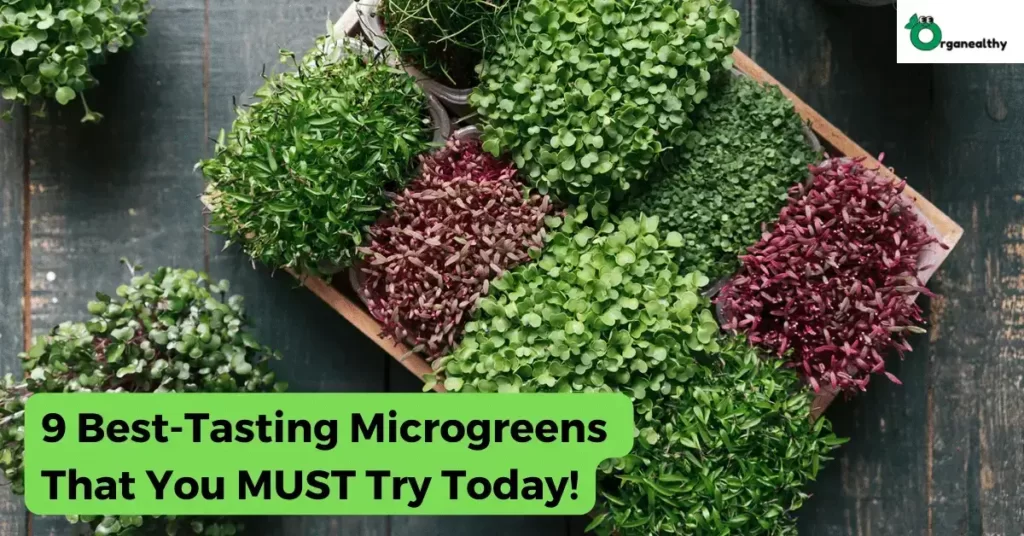
9 Best Tasting Microgreens at a Glance
| Microgreens | Taste | Best Variety to try |
|---|---|---|
| Mustard | Spicy and a little sweet | Brown mustard other names: Indian mustard, leaf mustard, Oriental mustard, or vegetable mustard. |
| Pea | Sweet and mild, mostly like the mature peas | English peas, snow peas |
| Radish | Zesty and peppery, like radish bulbs | Japanese daikon, rainbow mix, Rambo radish microgreens |
| Broccoli | Crunchy flavor with a mildly bitter taste | Calabrese broccoli microgreens |
| Arugula | Sharp and tangy | Astro, Wasabi, and Garden Tangy |
| Cress | Piquant, peppery flavor | American cress, Upland cress |
| Beetroot | Earthy, like beetroots | Bull’s blood beetroot microgreens |
| Mesclun Mix | Depends | mesclun mix of arugula, radish, mustard, and pea microgreens |
| Cilantro | Citrusy | Slow Bolt and Leisure Splits |
9 Best Tasting Microgreens to Try Today
Microgreens were introduced to the mainstream in the 1990s when Californian chefs started using them in their gourmet dishes to add visual appeal.
The mainstream consumers were quick to understand microgreens’ health benefits – they possess 9 times more nutrients than mature vegetables – and loved the surprisingly delightful flavor.
Now, we will discuss the 9 best tasting microgreens. Some of them come in multiple variants, so I will also tell you which variant you should go for.
1. Mustards
Taste: Spicy and a little sweet
Varieties to try: Brassica juncea, commonly known as brown mustard, Indian mustard, leaf mustard, Oriental mustard, or vegetable mustard.
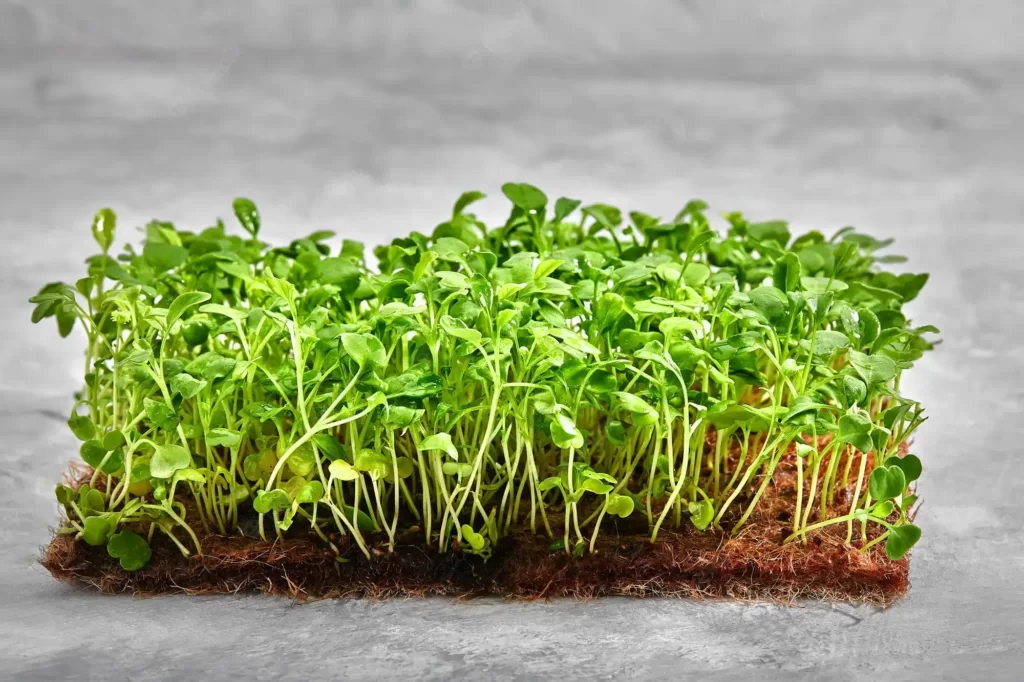
Did you already guess this one?
Mustard has been a part of human consumption for more than 5000 years. It is popular in both forms – seeds and leaves.
Black mustard (brassica nigra) is traditionally grown for its seeds which are usually used as a spice, but you can grow them as microgreens too.
Due to their high antioxidant content, mustard microgreens are said to fight colon, bladder, and lung cancers.
Some people love a good bowl of mesclun mix once a day but are bored of its mild taste. So, you can add a bunch of mustard microgreens to this mix and spice up your taste buds.
2. Pea
Taste: Sweet and mild, mostly like the mature peas
Varieties to try: English peas, snow peas
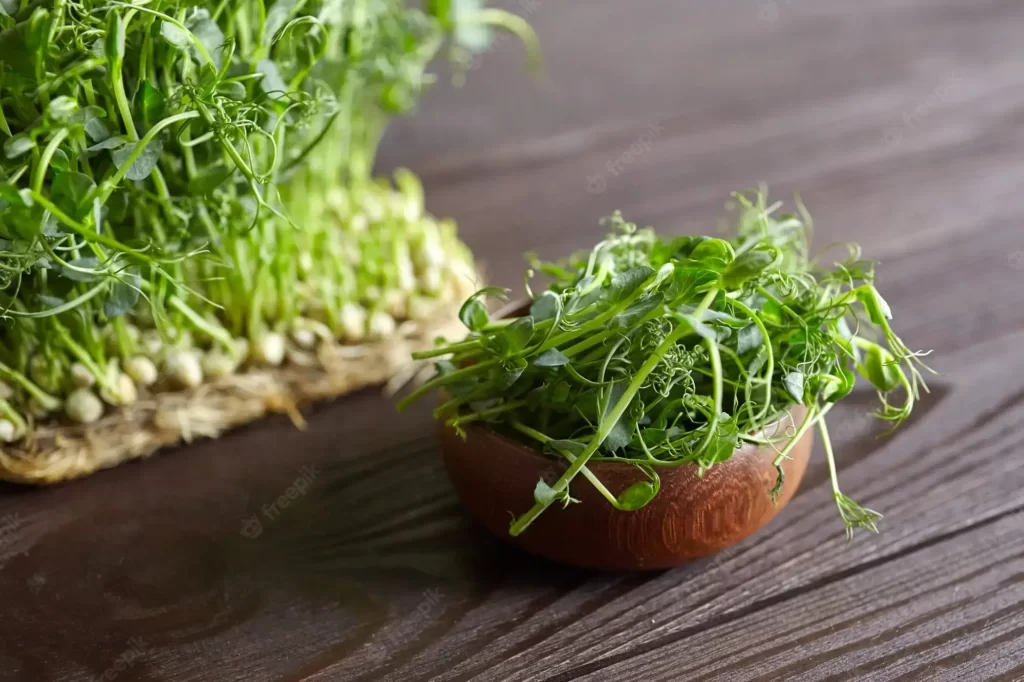
Pea microgreens are quite a popular choice among microgreens consumers. They grow in high density and, thus, can be grown even in little quantities for self-consumption.
Some microgreens grow the best when pre-soaked; pea microgreens, too, grow better when pre-soaked for 6 to 24 hours. You can harvest them at 5 cm.
Pea microgreens, due to their sweet and mild taste, blend well with salads, cooked meals, and even meat. They are filled with various essential nutrients and minerals like protein, carbohydrates, iron, niacin, magnesium, zinc, vitamin C, and vitamin B1.
3. Radish
Taste: Zesty and peppery, like radish bulbs
Varieties to try: Japanese daikon, rainbow mix, Rambo radish microgreens
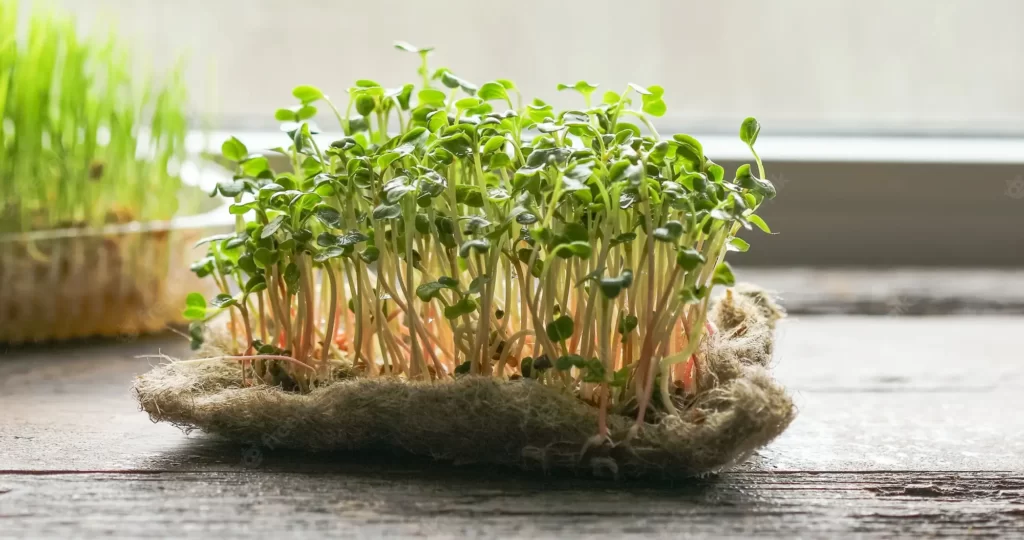
Radish, botanically known as Raphanus Sativus), is a great option to start growing your microgreens indoors.
Radish seeds germinate quickly in both cool and warm weather conditions, and the microgreens become harvestable in 8 to 10 days.
Due to their zesty and peppery flavor, radish microgreens add a touch of spiciness to your salads and sandwiches. The intensity of radish microgreens increases over time. That’s why the older ones taste hotter but a little woody.
You can use the older shoots in soups and stocks to make them healthy and tasty.
Radish microgreens are also one of the few microgreens that have antiproliferative cancer properties – ranking evenly with broccoli microgreens.
The red Rambo radish microgreens are not just one of the best tasting microgreens but also one of the most nutritious varieties – filled with vitamins, minerals, and antioxidants.
4. Broccoli
Taste: Crunchy flavor with a mildly bitter taste
Varieties to try: Calabrese broccoli microgreens
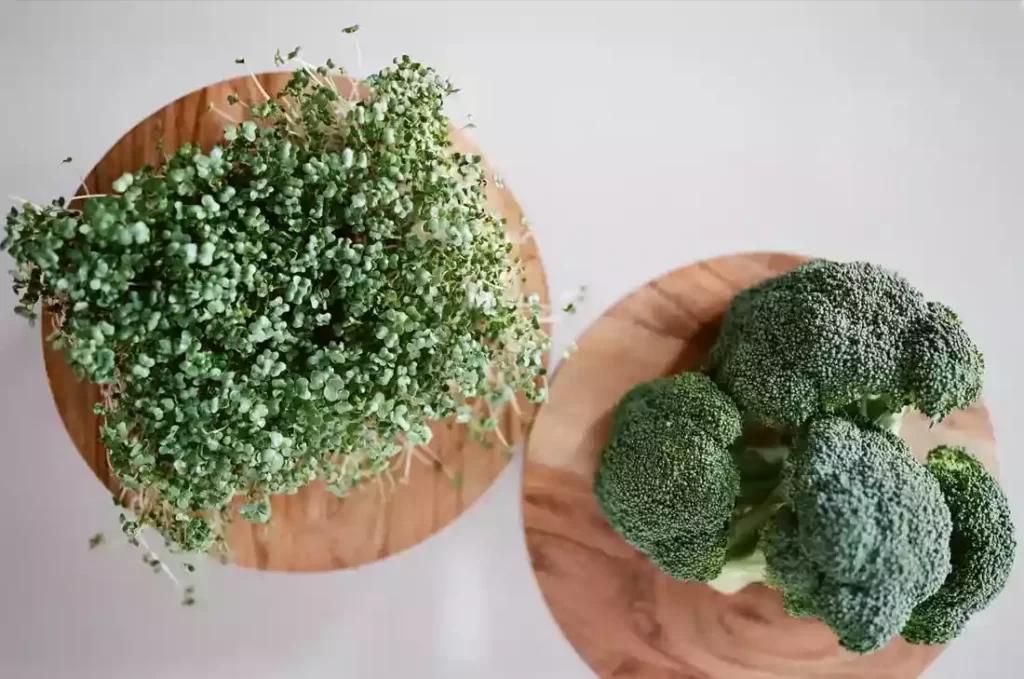
Broccoli microgreens – I know you’re waiting for this one!
Broccoli microgreens are filled with iron, minerals, vitamin A, and vitamin C. Also, it contains sulforaphane which is linked to cancer prevention.
Many studies have shown that a couple of ounces of broccoli microgreens every day will comparatively elevate the body’s protective enzymes.
Many fitness enthusiasts never forget to add broccolis to their meals due to its health benefits. Broccoli microgreens are popular for their crunchy flavor, and their mild, bitter after-taste.
Broccoli has to be one of the easiest microgreens to grow, germinating readily from 10°C-25°C. Spread them thickly for a larger harvest.
Just like radish microgreens, broccoli greens are best cut young at the true leaf stage and high in the stem.
5. Arugula
Taste: Sharp and tangy
Varieties to try: Astro, Wasabi, and Garden Tangy
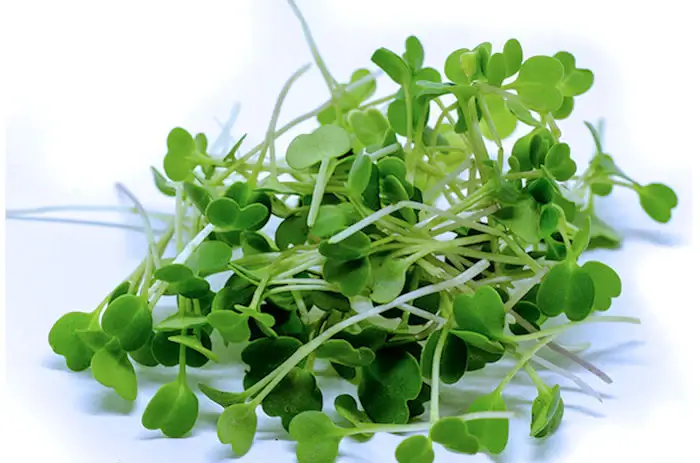
Arugula – botanically known as eruca sativa – is native to the Mediterranean and has been quite a popular salad herb since Roman times!
Arugula microgreens are one of the tastiest microgreens out there due to their tangy, sharp, and refreshing taste.
Tired of all mild, bitter microgreens? Try Arugula microgreens today.
Iceberg lettuce is a popular ingredient in salads, but here are some cool facts – arugula microgreens contain 8X calcium, 5X vitamins A, C, and K, and 4X iron than iceberg lettuce.
Arugula is a winter crop, as it germinates at a temperature of as low as 5°C and grows much faster in cool weather.
So, if you grow them, remember to harvest and wash them extra carefully, as they get bruised easily.
6. Cress
Taste: Piquant, peppery flavor
Varieties to try: American cress, Upland cress

Cress – scientifically known as Lepidium sativum – is not just one of the best-tasting microgreens for its peppery, piquant flavor.
Also, due to their high demand in supermarkets, Cress microgreens are one of the most profitable microgreens to grow.
Since Cress is closely related to mustard and watercress, you can use them as alternatives in your dishes. If you use them together, they just complement each other.
I’d recommend you try using Cress in herb butter or even the traditional mix with mayonnaise, egg, and lashings of black pepper served in between hot bread pieces.
Cress is filled with antioxidants, calcium, manganese, and vitamins such as A, C, and K. Cress microgreens are known to be one of the most nutrient-dense foods due to their low-calorie and high-nutrients composition.
7. Beetroot
Taste: Earthy, like beetroots
Varieties to try: Bull’s blood beetroot microgreens
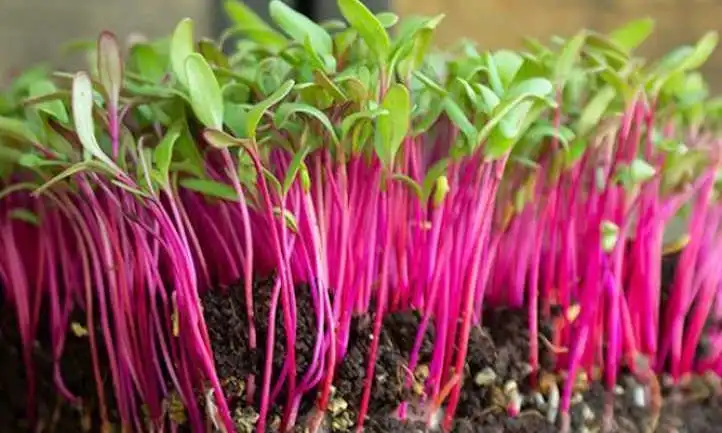
Beet microgreens are popular for their intense red color, and thus they are mostly used in salads, sandwiches, and toppings. They blend with any dish because of their earthy flavor, just like beetroots.
If you wish to grow beetroot microgreens, then ensure you pre-soak them and sow them thickly.
Bull’s Blood beet microgreens are loved by chefs and foodies for their contrasting colors, crunchy yet juicy texture, and distinct earthy flavor. Bull’s Blood tastes like a sweet mix of spinach and root beets.
8. Mesclun Mix
Taste: Depends on what microgreens you use in the mix
Varieties to try: Try a mesclun mix of arugula, radish, mustard, and pea microgreens.

In Provençal cuisine, mesclun is a mixture of tender salad greens and herbs. Its genesis is the French word “mesclar,” which means “mixture.”
Traditionally, a mesclun mix includes arugula, oak leaf, chervil, and mâche.
So, if you too want different flavors on your plate – try a mesclun microgreens mix. Just throw in your favorite microgreens together, add a pinch of seasoning and a salad dressing, and relish the best tasting microgreens.
You can mix and match different microgreens as per your taste. Some microgreens will add color to your dish, while some add that punch of refreshing taste.
9. Cilantro
Taste: Citrusy, lime/lemon-like flavor
Varieties to Try: Slow Bolt and Leisure Splits from True Leaf Market

Here’s a fun fact – the coriander seeds are referred to as coriander; when the leaves grow, they are no longer coriander – they are CILANTRO!
You can eat them as sprouts, but microgreens are much tastier and safer than sprouts.
Cilantro microgreens are surely one of the best tasting microgreens for their zesty flavor and nutritional density. Like most microgreens, cilantro microgreens are easy to grow.
In most cuisines, cilantro is used as a topping to add a fresh, aesthetic green color to a dish, but cilantro microgreens are much more than that.
With its citrusy, lemon/lime flavor, Cilantro microgreens add a mild warmth or kick to your food.
Why Should You Grow and Eat Microgreens?
Most microgreens sellers sell fresh products to their local grocery stores, and then you can buy them from the store.
But, if you’re willing to put a little more effort and try growing microgreens for self-consumption, then do try growing one of these varieties in your backyard.
Add them to your salads or chop them and add them as a topping, your choice!
If you ever wanted to try your hand at gardening, then the best tasting microgreens are worth a try.
That’s about why you should grow microgreens, about why you should eat them – microgreens are delicious!
Apart from their rejuvenating taste and vibrant colors, microgreens are a powerhouse of antioxidants, vitamins, calcium, and other nutrients and minerals. Microgreens make your food look better, taste better, and more nutritious.
Another reason to start eating microgreens today is their health-promoting and disease-preventing benefits. Although there have been limited studies on microgreens, the conclusions are positive.
Do Microgreens Taste Good?
Yes, microgreens taste AMAZINGLY good!
Not only that, but most microgreens are way healthier than their mature counterparts, plus they have a variety of flavors from spicy or peppery to sweet or nutty, even mild and earthy or herb-like, and so much more!
The Final Word
Microgreens are available throughout the year. You can find them in your nearest grocery stores all year long.
Most microgreens are suitable to be consumed in any weather – it’s the personal taste that matters. If you want to add a punch of taste to your daily meals, try zesty microgreens like arugula, cress, mustard, and radishes.
If you want to try a milder taste then go for carrots, cabbage, broccoli, chard, and spinach – you can even mix them up and create a salad mix.
The list of best tasting microgreens that I shared above might have left you drooling, and I recommend you try each one of them.
Let me know which ones you loved the most!



